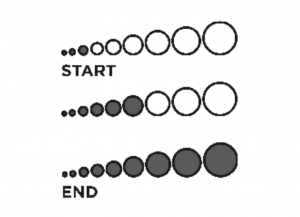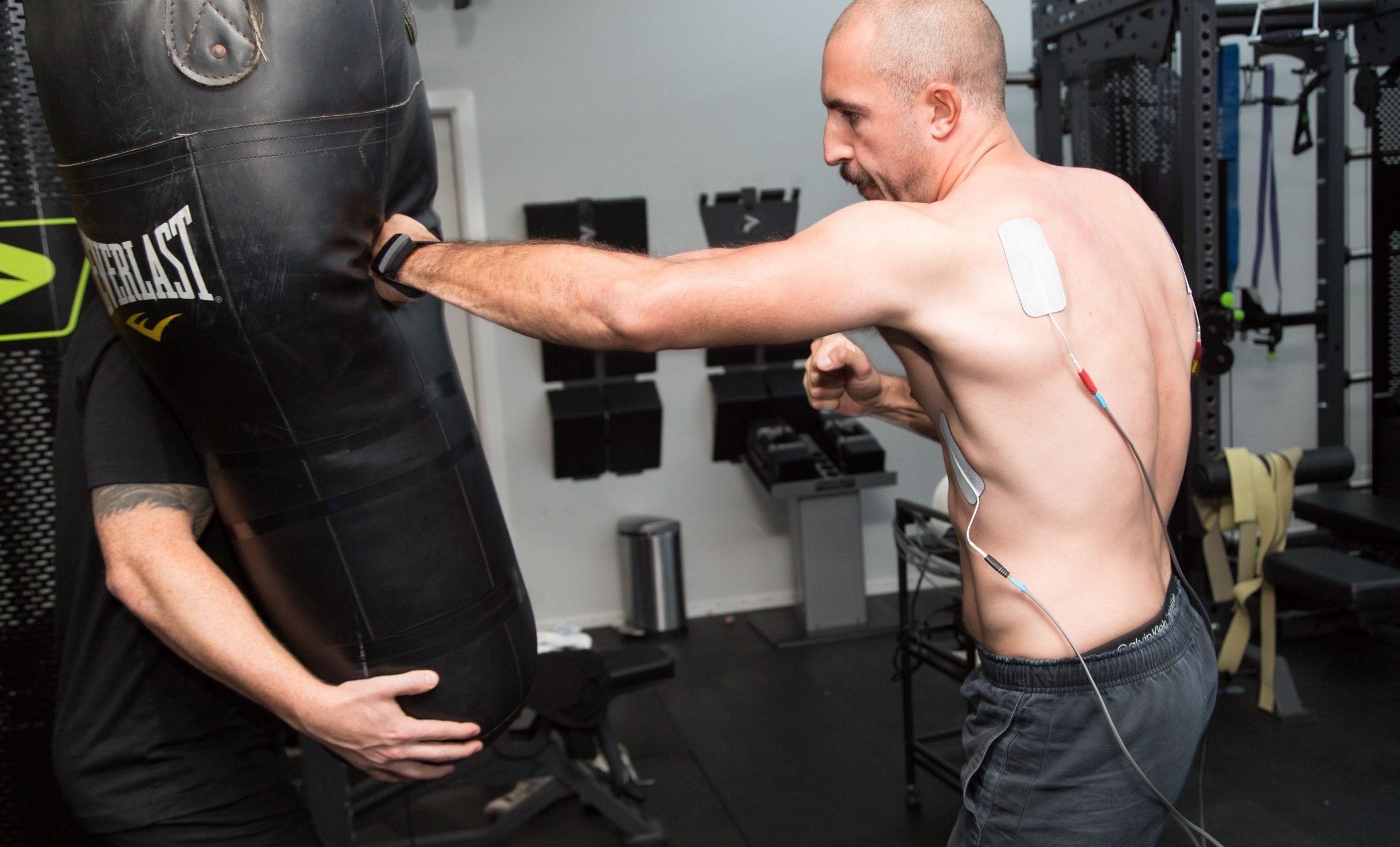Training the body to resist injury, especially in specific situations and in specific positions, is an important dimension of resilience that we incorporate into our training at NeuFit®.
So, what does this look like in practice?
When a patient is on the tennis court and changes direction, for example, this puts quite a bit of lateral tension on the ankle ligaments. In this situation, if they roll their ankle and it can’t handle that tension or force, then they run the risk of injuring themselves.
Fortunately, we can work toward preventing these types of injuries by challenging the muscles and connective tissues and training them to handle higher levels of force. When a patient starts training with the NeuFit Method, for example, their ankle might have been able to manage 150 pounds of force before its ligaments would tear.
Using strategic mobility drills that load the ligaments and connective tissue in the inversion position, over time, the ankle reached the point where it could handle significantly more force, say 250 pounds. (This is due to a phenomenon called Davis’s Law—another aspect of specificity of adaptation—that describes how connective tissues adapt and remodel to meet the body’s demands.¹)
Now that they can handle higher levels of force in his ankle, our patient is much less likely to roll or invert it the next time they change direction on the tennis court—and much less likely to be injured if they do roll it. In other words, their capacity to handle more force translates into greater resistance to injury.
Building Resilience to Environmental Stressors
Building resilience through activities like cold exposure is another useful tool for training the nervous system and the body to better handle stress. Besides reducing inflammation² and helping improve the metabolism,³ cold exposure —in the form of ice baths, cold showers, cold water swimming, and/or cryotherapy chambers—is a powerful technique for increasing the threshold between the sympathetic and parasympathetic nervous systems.4
Exposure to cold temperatures usually causes the nervous system to start panicking and shift into fight-or-flight mode. If someone jumps into an ice bath, for example, their brain’s first reaction is to perceive the freezing temperature as a threat to survival. In response, the body releases stress hormones and redistributes blood, moving it away from the extremities and into the organs to preserve its core temperature. Though this is a healthy physiological response, the goal is to be able to redistribute blood using only the necessary amount of sympathetic response—and no more than that. In simple terms, the goal is to react, not to overreact.
With cold exposure therapy, we can learn to manage this threat response by teaching the nervous system to respond differently to changes in temperature. Instead of panicking in the ice bath, intentionally slowing down the breathing and consciously calming the mind builds the nervous system’s capacity to handle greater levels of challenge and stay in a healthy parasympathetic state. With training, people can learn to handle cold exposure without having a major fight-or-flight response and calling upon reserves of stress hormones. As mentioned earlier in this chapter, this allows them to reserve these hormones for situations when they need them most.
There are various ways to incorporate cold exposure into training. Twenty to thirty seconds of cold water in the shower are generally enough to get started.
Additional Exercise Techniques
Yielding isometrics and End Range Activations (ERAs) are manual exercise techniques that build resilience by increasing strength, endurance, and range of motion while simultaneously decreasing injury risk.
Though they’re more effective when combined with the electrical stimulation of the Neubie® neuro-electrical stimulation device, both yielding isometrics and ERAs can be beneficial when practiced on their own.
ERAs and yielding isometrics are similar in that they both build resilience by intentionally training through a fatigued state (and doing it in a safe and controlled way). The main difference between the two is that ERAs involve starting in the lowest position while yielding isometric exercises start in the highest position.
How exactly do these exercises work? Through long holds of strategic positions, both ERAs and yielding isometrics trigger greater muscle recruitment than traditional body-weight exercises.
In the beginning, a portion of the available motor units activate, signaling the associated muscle fibers to contract. As time goes on, the first groups of muscle fibers churn through their existing energy supply, and fatigue sets in. The body responds by calling on additional motor units in the muscles to handle the load. Eventually, as fatigue builds, the body calls on the most powerful motor units, which typically only activate when lifting heavy weights.
This image shows how the muscle recruitment process plays out over the course of an exercise:5

In the later stages of these exercises, it’s common to feel (and see) the muscles shaking. This shaking is to be expected since it’s part of the subtle shifts between the areas of the muscles bearing the load. Assuming it’s not due to any underlying health issues, shaking is a sign of increased neurological output and activation of a broad range of motor units and muscle fibers within that muscle group.
Both ERAs and yielding isometrics provide many of the same benefits as heavy lifting. At the same time, they minimize the risk of injury in two ways:
- By training eccentric muscle contractions, in which the muscle fibers learn to lengthen to protect the body, as they do during the deceleration phase of movement.6
- By creating muscle activation throughout the entire range of motion, especially at the end ranges where the body has the least amount of control. This trains the muscles to protect the body in the ranges where it’s most vulnerable to injury.
Isometric and ERA Exercises
Here are a few examples of yielding isometric and ERA exercises (visit www.neu.fit/book for more instruction on ERA and yielding isometric exercises, along with a sample workout):
- The Two-Minute ERA Lunge: This exercise is partially inspired by martial arts traditions, in which practitioners hold certain positions (e.g., horse stance) for long periods of time to promote vitality and resilience. As an ERA exercise, holding the bottom of a lunge position for two minutes (or more) is a safe way to increase the level of challenge while increasing endurance and strength, particularly in the lower body. The goal is to actively attempt to sink lower and lower in the lunge throughout the exercise, so the muscles continue to lengthen and actively stabilize the joints for the entire duration.
- The Two-Minute Push-up: This exercise involves holding the bottom of a push-up position, working up to two minutes initially, and progressing to longer holds over time. Like the lunge, it’s a hold at the bottom position with an intention to continue lowering the body throughout the exercise. Since doing it on the floor limits the range, it’s best to practice it with the hands on a chair or a handle of some sort, which makes it easier to lower the body even further.
- The Two-Minute Yielding Isometric Shoulder Raise: This shoulder-training exercise involves holding light dumbbells—often just two to three pounds—while extending the arms to the front or the side. When the arms start to fatigue, they naturally drop. Instead of raising them again, the idea is to continue to hold the arms in the lowered position. This helps promote eccentric muscle contractions, which strengthen the muscle fibers in a way that increases their ability to resist injury.
In next week’s blog, we are going to discuss strengthening psychological resiliency. Until then…
Let’s charge forward to better outcomes together!
¹ C. J. Cyron and J. D. Humphrey, “Growth and Remodeling of Load-Bearing Biological Soft Tissues,” Meccanica 52, no. 3 (June 27, 2016): 645–64, https://doi.org/10.1007/ s11012-016-0472-5.
² P. Vargovic, G. Manz, and R. Kvetnansky, “Continuous Cold Exposure Induces
an Anti-Inflammatory Response in Mesenteric Adipose Tissue Associated with Catecholamine Production and Thermogenin Expression in Rats,” Endocrine Regulations 50, no. 3 (July 1, 2016): 137–44, https://doi.org/10.1515/enr-2016-0015; Gracielle Vieira Ramos et al., “Cryotherapy Reduces Inflammatory Response Without Altering Muscle Regeneration Process and Extracellular Matrix Remodeling of Rat Muscle,” Scientific Reports 6, no. 1 (January 4, 2016), https://doi.org/10.1038/ srep18525; Yizhen Nie et al., “Cold Exposure Stimulates Lipid Metabolism, Induces Inflammatory Response in the Adipose Tissue of Mice and Promotes the Osteogenic Differentiation of BMMSCs via the p38 MAPK Pathway in Vitro,” International Journal of Clinical and Experimental Pathology 8, no. 9 (September 2015), 10875–86, https://pubmed.ncbi.nlm.nih.gov/26617802.
³ Anouk A. J. J. van der Lans et al. “Cold Acclimation Recruits Human Brown Fat and Increases Nonshivering Thermogenesis,” Journal of Clinical Investigation 123, no.8 (July 15, 2013): 3395–3403, https://doi.org/10.1172/jci68993; Wouter van Marken Lichtenbelt et al., “Cold Exposure: an Approach to Increasing Energy Expenditure in Humans,” Trends in Endocrinology & Metabolism 25, no. 4 (April 2014): 165–7, https://doi.org/10.1016/j.tem.2014.01.001; Véronique Ouellet et al., “Brown Adipose Tissue Oxidative Metabolism Contributes to Energy Expenditure during Acute Cold Exposure in Humans,” Journal of Clinical Investigation 122, no. 2 (February 1, 2012): 545–52, https://doi.org/10.1172/jci60433.
4 Tiina M. Mäkinen et al., “Autonomic Nervous Function During Whole-Body Cold Exposure Before and After Cold Acclimation,” Aviation, Space, and Environmental Medicine 79, no. 9 (September 1, 2008): 875–82, https://doi.org/10.3357/asem.2235.2008.
5 This discussion of motor units and the associated image are adapted from: Vladimir M. Zatsiorsky and William J. Kraemer, “Training Intensity” in Science and Practice of Strength Training, 2nd ed. (Champagne, Illinois: Human Kinetics, 2006); Vladimir M. Zatsiorsky and William J. Kraemer, “Strength Exercises” in Science and Practice of Strength Training, 2nd ed. (Champagne, Illinois: Human Kinetics, 2006).
6 Paul C. LaStayo et al., “Eccentric Muscle Contractions: Their Contribution to Injury, Prevention, Rehabilitation, and Sport,” Journal of Orthopaedic & Sports Physical Therapy 33, no. 10 (October 2003): 557–71, https://doi.org/10.2519/jospt.2003.33.10.557.

